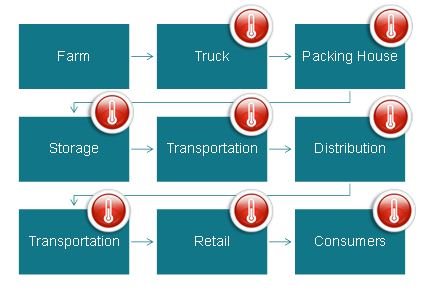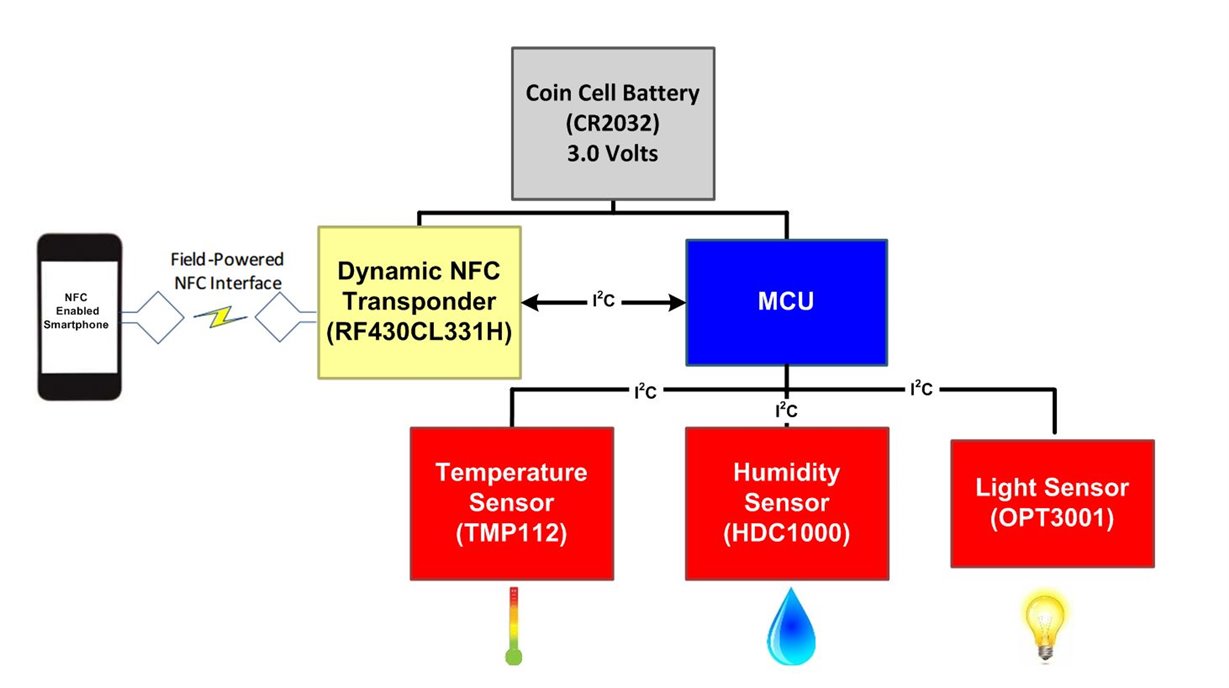SSZTBW3 november 2015 HDC1000 , MSP430FR5969 , OPT3001 , RF430CL331H , TMP107 , TMP112
Have you ever had a shipment of expensive temperature-sensitive prescription drugs sent to your home? What if the container was opened allowing the contents to increase in temperature and you weren’t absolutely sure how high of a temperature and for how long the medicine had been exposed to? Well, this happened to my family and it was not a pleasant exercise trying to determine if the drug was still usable.
In this blog post, I will discuss an industrial application of the Internet of Things (IoT) that involves the process of manufacturing, packaging and shipping perishable goods – called the “cold chain” – and how a simple, low-cost solution called a data logger would have been useful in my situation.
Cold-chain management, which is a form of asset tracking, entails all of the means used to ensure a constant temperature for a product from the time it is manufactured or farmed until it is used or consumed. These are just some of the industries involved:
- Food.
- Retail.
- Medical (hospitals – transplants, blood plasma).
- Pharmaceutical.
- Transportation (air, ocean, ground, rail).
- Warehousing.
Figure 1 is a flow diagram of a food cold-chain management process with the thermometer symbol representing a step that may require temperature monitoring.
 Figure 1 A Flow Diagram of the Food
Cold-chain Management Process
Figure 1 A Flow Diagram of the Food
Cold-chain Management ProcessKnowing and recording the temperature of the shipment during every step of the cold chain holds every party involved in the process accountable. Fortunately, regulatory agencies are creating mandates to ensure accountability and liability. One example is the U.S. Food and Drug Administration (FDA) Food Safety Modernization Act (FSMA), which is a law passed in 2011 to ensure that the food supply is safe by shifting the focus from responding to contamination to preventing contamination. Because of this law, the use of temperature equipment that constantly monitors and logs or reports data in real time will expand. While temperature-tracking equipment is currently used for large shipments, as the regulations become more pervasive, you will eventually find such monitoring directly on shipping pallets and even in multiple locations within the pallets.
Temperature-tracking equipment includes temperature indicators and data loggers. Temperature indicators are single-event temperature excursion indicators. They are typically disposable and available in at least two varieties: chemical-based or electronic. Data loggers are more complex solutions, as they are designed to issue an alert in case a shipment falls outside of an expected temperature window. They may also log other parameters such as humidity, light exposure and vibration. Data loggers may be available in wired solutions (as is the case in a refrigeration truck that constantly monitors multiple locations) or wireless (near field communication [NFC], Bluetooth® low energy [BLE], ZigBee, Wi-Fi, cellular, satellite).
We recently added to our extensive temperature-sensing portfolio the TMP107 temperature sensor integrated circuit (IC) that features an accuracy of ±0.4°C from -20°C to +70°C. It allows for a 32-device daisy-chain implementation on a single communication line, which engineers can use in systems to monitor temperature in multiple locations without all the extra cabling of alternative solutions. To help engineers jump-start their data logging applications, TI has developed a complete reference design for asset tracking and cold-chain data logging with a battery life of over five years and a NFC interface for configuration and read-back. The hardware design, which will be available for purchase by the end of the year, combines several TI sensing ICs, as well as a new NFC device and ultra-low power microcontroller (MCU). For maximum flexibility, the reference design offers the choice of multiple sensor configurations to monitor temperature (TMP112), ambient light (OPT3001) and/or humidity (HDC1000). NFC is provided by TI’s RF430CL331H and up to 64KB of nonvolatile FRAM memory is available with the MSP430FR5969 MCU. Figure 2 is a simple block diagram of the design.
 Figure 2 A Block Diagram of an Asset
Tracking and Cold-chain Data Logging System
Figure 2 A Block Diagram of an Asset
Tracking and Cold-chain Data Logging SystemThe TMP112 is a device that is National Institute of Standards and Technology (NIST) traceable. This means production units are 100% tested against sensors that are NIST-traceable and are verified with equipment that are NIST-traceable through ISO/IEC 17025 accredited calibrations. In time TI will offer more devices with NIST traceability, which will provide end users an unbroken chain of measurements and associated uncertainties, enabling designers to trace the accuracy level of their end product’s temperature measurements. NIST-traceable devices will become more commonplace on a worldwide basis as governing bodies introduce further regulations.
I believe that the cold chain is here to stay and will drive the need to monitor shipments more in this new era of the IoT. By knowing the exact temperature reached during the shipping process and how long it stayed outside the recommended temperature range, our pharmacist would have the proper information to decide whether to discard or use the prescription drug. With cold chain data logging, I will be able to know if my expensive pharmaceuticals were maintained at the proper temperature throughout the distribution cycle.
Additional Resources
- Order the TMP107 evaluation module (EVM).
- Check out the TI Designs Ultra-low-Power Multisensor Data Logger with NFC Interface Reference Design.
- Read the application note, “Semiconductor Temperature Sensors Challenge Precision RTDs and Thermistors in Building Automation.”
- Read the blog post, “Ditch the NTC thermistor: use an analog temp sensor.”